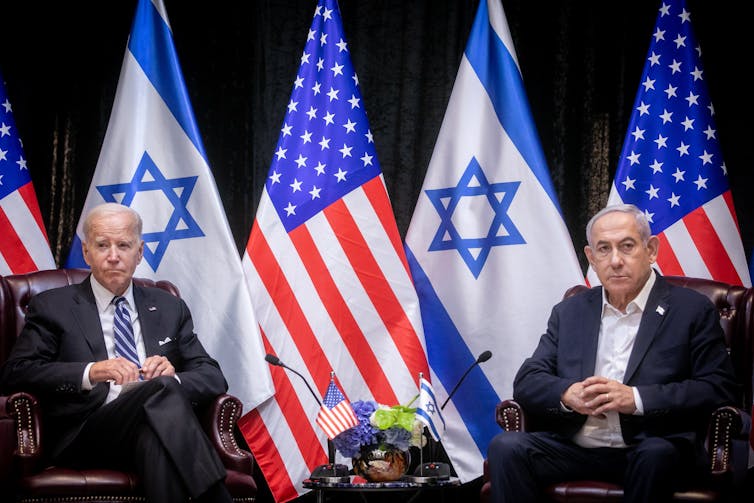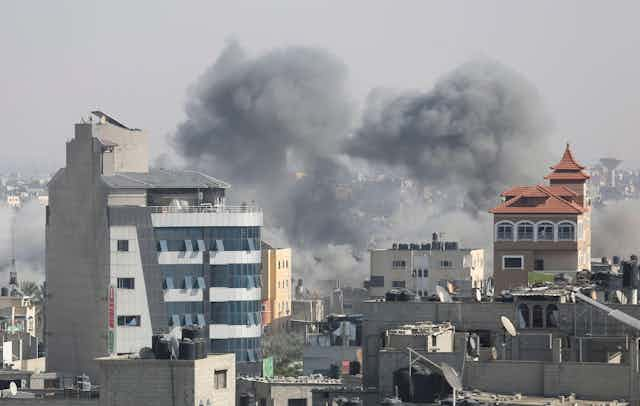After Hamas’s deadly attacks on October 7, a ground invasion of the Gaza Strip by the Israel Defence Forces (IDF) appeared inevitable. Benjamin Netanyahu’s government apparently had little choice, given that the attack shocked Israel to its very core.
The IDF failed to prevent or plan for the attack, while the government’s hubristic view that Israel could tacitly support Hamas’s rule in Gaza, thereby dividing the Palestinians while indefinitely containing their aspirations for statehood, proved fundamentally flawed.
But nearly two-and-a-half weeks into the war, Israel’s ground invasion has yet to materialise. Instead, both sides have settled into an all-too-familiar pattern of tit-for-tat rocket and airstrike exchanges. Why, then, have Israel’s actions not matched its rhetoric?
Two intertwined factors – incorporating both Israel’s internal and external politics – explain this operational inertia.
The first is US-Israel relations. Biden administration officials initially refused to call for Israeli restraint and even backed a ground invasion. This differs to previous rounds of escalations, where US pressure was a critical factor in persuading Israel to agree to a ceasefire.
But the familiar dynamic soon returned. Biden warned Israel to respect the “laws of war” and protect Gaza’s civilians. The White House also overcame Israeli intransigence to allow aid to enter the territory. Now, since Hamas has released four hostages, the US is again pressing for time to bring more Israeli civilians home without a further escalation.
Israeli pundits are railing against a supposedly weak and gullible US for falling for Hamas’s delaying tactics. But the reality is closer to home. It is not Hamas, but internal dissent at the highest levels of Jerusalem’s political and military elite that has caused the US to temper Israel’s war plans.
Ground invasion and the day after
Since the conflict began, US officials have been pressuring Israel to answer two questions. First, what a ground invasion would look like. And second, how Israel would translate any military success into a comprehensive political plan for Gaza after it removes Hamas from power.
It is Israel’s inability to answer these questions that have driven the US to tentatively push for de-escalation. Israel’s political and military elite remain divided over what a ground invasion would look like and what the long-term political objectives should be.

Before October 7, Israel’s leadership was united in a belief that keeping Hamas in power was preferable to reoccupying Gaza, given that any intervention would create an unpalatable number of casualties and significant international censure.
Hamas’s ferocious attacks destroyed this consensus, but a new one has not replaced it. The IDF is pushing for a comprehensive ground invasion that would seize the entire territory by land, sea and air. Other security experts advocate that Israel tighten its blockade and occupy the less-populated areas in Gaza’s southern and middle regions. In so doing, Israel could apparently avoid a prolonged urban conflict in the most densely populated parts of the territory but still force Hamas to eventually capitulate by making Gaza unliveable.
Netanyahu’s far-right coalition partners also advocate this siege model but want to use it as a springboard to advance their political agenda, that is, complementing a military occupation with civilian settlement and eventual annexation of these sparsely populated parts of Gaza.
Netanyahu’s position
Netanyahu himself is racked by at best indecision and at worst the paranoia that has recently underlined his leadership. Israel’s longest-serving prime minister remains reluctant to abandon the pre-war status quo and would prefer short-term, surgical raids by special forces.

Complicating matters, both Netanyahu and the IDF elite are distracted by blame-shifting, with media leaks pointing the finger at each other for the October 7 attacks and Israel’s ongoing political and military paralysis.
It is therefore unsurprising that nobody in Israel can agree on the even thornier question of what comes next if the IDF does manage to end Hamas’s rule. Israel’s public representatives have even verged on boasting that no-one currently cares to consider this question.
The entry of the relatively moderate Blue and White Party into Israel’s “emergency coalition” government has partly assuaged the US. Party leader, now defence minister Benny Gantz, has convened a committee charged with determining the future of Gaza after Hamas.
But this may be too little, too late. Israeli governmental committees are not known for their swift decision-making, while Netanyahu has consistently worked to monopolise power and minimise the policy-making inputs of Blue and White, the IDF elite and even his own defence minister.
It is this indecision, internecine bickering and – most of all – the lack of a long-term plan that most worries the Biden administration. And for good reason. My own research has illustrated that occupiers often fall into “the occupation trap”. They fail to engage in post-intervention planning and as a result sink into an unwinnable quagmire with no achievable political goal.
The result is usually an ignominious withdrawal, coupled with a post-exit political future that looks remarkably like the pre-occupation status quo – contemporary Afghanistan represents a timely example.
The US has learned these lessons – Israel apparently has not. This is all the more surprising given that when Israel created a “security zone” in southern Lebanon in 1985, then defence minister, Shimon Peres, claimed that year would be the IDF’s last in the country. It was not.
Israel did not end its occupation until mid-2000, having failed to achieve any of its objectives and empowering Hamas’ allies – Hezbollah – to take credit for an Israeli “retreat”.
Israel, then, does not need to look as far afield as Iraq and Afghanistan to realise the strategic folly in failing to plan for a day after Hamas scenario.


